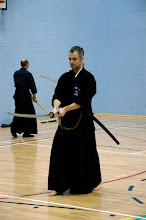It can sometimes be very rewarding to teach beginners as they have few expectations and biases and are a mostly empty cup to fill.
Putting your brain into the student mindset
Those of you who have been living in my eyebrows for the last few years will know that my budo interests have been steered towards improving budo coaching through some shallow dives into sports coaching theory. These dives have taken me past the colourful coral gardens of ZPD, scaffolding, the GROW model and other interesting underwater features. These have been very much focussed on the role and workload of the coach/teacher/dojo leader and has treated the receiving side as a pretty much homogenous mass of pink jelly that responds to the occasional blast of sound vibrations or poking with a sharp stick.
This year I have so far spent just over 9 weeks in Japan doing a lot of training in Ishido Sensei's dojo, and a little in other dojos. Something that occurred to me in my latest journeys was a noticeable difference in the responses of students with regard to feedback from various teachers. This hasn't been isolated to Japan; once it came to my interest in Japan I started noticing it in the UK and Europe as well.
Before I jumped into writing this, I did some light academic research looking at various articles on the subject of corrective feedback in coaching. I have extracted a few lines from the articles that I found relevant and interesting to just set the scene. These are not only useful for the student but also a superb set of pointers for coaches as well:
The Organization of Corrective Demonstrations Using Embodied Action in Sports Coaching Feedback
"However, unlike classrooms and medical internship discussions, sports coaching is a bodily affair; there is no “talking through a subject” to get the job of these settings done. Errors then are not a matter of what one knows but what one does. Error correction is a matter of showing the athlete(s) what they did wrong and showing them how to do it right. Talk is an instructive guide on where to find the action, but re-enactment is the central part of this setting’s instructional work."
Five Principles of Reinforcement
"Coaches should strive to use only reinforcement – mostly the positive kind – to shape player behaviours."
"Nonetheless, if you say “well done” when the athlete has not performed the skill very well, it’s false praise, and the odds are that the athlete will know it’s false praise. It’s tough being honest sometimes, but if you have built a supportive but challenging climate and you support your players striving to improve, then you’re in a good position to give honest feedback."
_________________________
What I want to focus on is something I have noticed in that, depending on the student, there can be an overly long process from the point of receiving feedback to making any changes, see image below.
I noticed in particular in Japan that the older students tended to skip the disappointment and acceptance stage. They might spend a bit more time improving their comprehension by asking for more detail and confirmation.- "I thought I was doing it right and you're telling me that I was wrong."
- "I have devoted so much time to doing it this way and now you're saying that I wasted my time."
- "You could have told me this sooner."
- "You're being inconsistent in your teaching of the subject."
And I get it! This person had been instructed a certain way a few months previously (I think by Ishido Sensei) and they were now being told this was wrong. Had the koryu changed? Had they misunderstood the original instruction?
- Loss of training and teaching time
- Problem identified and potential solution starts to become of secondary importance to proving the student is doing something wrong
- Teacher/coach can lose patience
- If I understand the critique and know what to do to resolve it, my simple answer is "Hai. Wakarimashita."
- If I understand the critique but don't know what to do to resolve it, my next simple question is, what should I do to make it right. In Japanese these could be easily asked by "Dou sureba ii deshou ka".
- If I don't understand the critique then I will ask a few more details; naturally this verbal response will depend on the situation but I will be careful to not suggest that I'm not doing the thing they are pointing out, for example:













